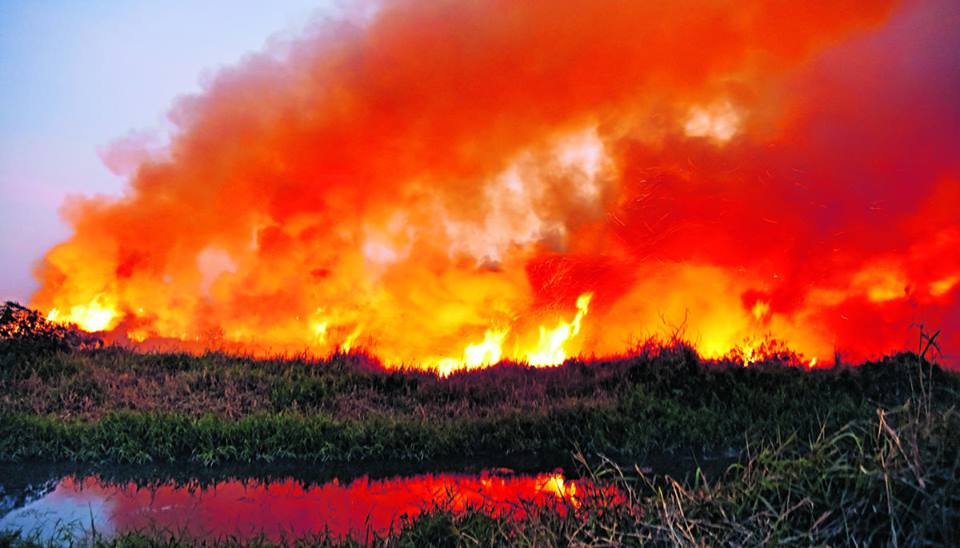Recurring outbreaks of fire in the Bellandur Lake in Bengaluru have caused much consternation amongst the city’s residents. How can the city’s largest lake, spread over 906 acres, catch fire?
Until the 1980s, the lake was home to a vibrant ecosystem with various species of birds, insects and fish thriving in it. It was also a popular destination for boat rides and family picnics. Today, the lake has become a cesspool, marked by fires and toxic foam, which occasionally spills over onto the city’s roads.
Last month there was a major fire that broke out on the lake, which raged on for several hours. The Indian Army had to be brought in to douse the fire. Both the Bruhat Bengaluru Mahanagara Palike (BBMP), the city’s apex municipal body, and the state pollution control board (PCB) suspected that alleged “miscreants” were behind the fire. As per an Indian Express report on last month’s incident, the PCB alleged that “miscreants set dry grass on the lakeshore ablaze.”
Going by this half-baked theory, the BBMP will step up surveillance in and around the lake using ex-army personnel and drones, according to The New Indian Express. They will patrol the areas around the lake, while “pilot camera-mounted drones” will fly over this massive water body. Who are these ex-army personnel? They are from the Madras Engineer Group (Madras Sappers) unit. The BBMP has also requested the service of two ex-Army personnel to operate the drones.
Additionally, the municipal body is also purchasing a motorboat for surveillance in and around the lake at the cost of Rs 2.5 lakh. “I have requested for someone from Madras Sappers to navigate the boat. The water is shallow and slushy, and there is a lot of hyacinths which makes it tough to manoeuvre it, and so we need the Army’s expertise,” said a senior BBMP official to the TNIE.
What these measures don’t resolve are the root causes of the toxic foam and fire that have become a recurring feature of the once-pristine Bellandur lake. Municipal bodies have failed to adequately regulate the explosion in real estate development surrounding the lake, resulting in the unregulated flow of sewage. With industries also mushrooming around the lake, toxic effluents have also flowed into the lake with little resistance.

“Discharge of untreated effluents (rich in hydrocarbons) with accidental fire (like throwing cigarettes, beedi) has led to the fire in the lake,” says a recent Indian Institute of Science study.
“Incidence of foam catching fire are due to compounds with high flammability, i.e., mostly higher hydrocarbons and organic polymers from nearby industries…High wind coupled with the high intensity of rainfall leads to the upwelling of sediments with the churning of water as it travels from a higher elevation to lower elevation, forming froth due to phosphorous,” the IISC study added.
The degeneration of Bengaluru’s lakes stems from the notorious builder-politician nexus which has rendered the BBMP and State PCB powerless to do anything about it. If anything, this is about the lack of political will to regulate the spurt of unplanned urban growth. Surveillance by ex-army personnel and drones will do little to prevent such incidents from occurring again.
Read also: Bellandur Lake Is on Fire and This Bengalurean Is Mobilizing Citizens to Get the Govt to Act!
However, there are solutions that authorities can implement in tandem with various stakeholders dedicated to cleaning up our fresh water bodies. Adding a mixture of nutrients to diatom algae, for example, can aid the process of treating large volumes of contaminants in the lake. There are also techniques like bio-remediation and bio-ozolyte, which were used to restore the Hauz Khas lake in the national capital. Innovative students from Bangalore’s CMR Institute of Engineering, for example, also found way to use fly ash to treat industrially polluted water or waterbodies.
For more on these solutions, you can read here.
It’s up to the residents of Bangalore to put necessary, and consistent pressure on civic authorities to address these concerns on war-footing. We cannot wait for the next time the lake catches fire.
Like this story? Or have something to share? Write to us: contact@thebetterindia.com, or connect with us on Facebook and Twitter.
NEW: Click here to get positive news on WhatsApp!</h4
If you found our stories insightful, informative, or even just enjoyable, we invite you to consider making a voluntary payment to support the work we do at The Better India. Your contribution helps us continue producing quality content that educates, inspires, and drives positive change.
Choose one of the payment options below for your contribution-
By paying for the stories you value, you directly contribute to sustaining our efforts focused on making a difference in the world. Together, let's ensure that impactful stories continue to be told and shared, enriching lives and communities alike.
Thank you for your support. Here are some frequently asked questions you might find helpful to know why you are contributing?

